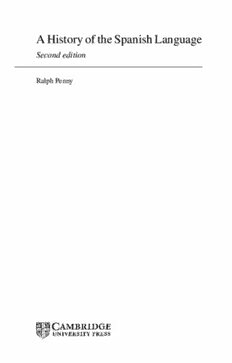
A History of the Spanish Language PDF
Preview A History of the Spanish Language
A History of the Spanish Language Second edition RalphPenny publishedbythepresssyndicateoftheuniversityofcambridge ThePittBuilding,TrumpingtonStreet,Cambridge,UnitedKingdom cambridgeuniversitypress TheEdinburghBuilding,CambridgeCB22RU,UK 40West20thStreet,NewYork,NY10011-4211,USA 477WilliamstownRoad,PortMelbourne,VIC3207,Australia RuizdeAlarco´n13,28014Madrid,Spain DockHouse,TheWaterfront,CapeTown8001,SouthAfrica http://www.cambridge.org (cid:1)C CambridgeUniversityPress1991,2002 Thisbookisincopyright.Subjecttostatutoryexception andtotheprovisionsofrelevantcollectivelicensingagreements, noreproductionofanypartmaytakeplacewithout thewrittenpermissionofCambridgeUniversityPress. Firstpublished1991 7thprinting2000 Secondedition2002 PrintedintheUnitedKingdomattheUniversityPress,Cambridge TypefaceTimes10/12pt SystemLATEX2ε [tb] AcataloguerecordforthisbookisavailablefromtheBritishLibrary LibraryofCongressCataloguinginPublicationdata Penny,RalphJ.(RalphJohn),1940– AhistoryoftheSpanishlanguage/RalphPenny.–2ndedn p. cm. Includesbibliographicalreferencesandindex. ISBN0521805872(hardback) ISBN0521011841(paperback) 1.Spanishlanguage–Grammar,Historical. I.Title. PC4101.P46 2002 (cid:1) 460 .9–dc21 2002025671 ISBN0521805872hardback ISBN0521011841paperback Content Listofmaps page xi Listoftables xii Prefacetothefirstedition xv Prefacetothesecondedition xvi Listofabbreviationsandsymbols xvii 1 Introduction 1 Time-line 1 1.1 Indo-European,LatinandRomance 2 1.2 TheLatinofSpain 8 1.2.1 Archaism 10 1.2.2 Conservatism 11 1.2.3 Dialectalism 12 1.2.4 Innovation 13 1.3 ConquestandReconquest 14 1.3.1 TheVisigoths 14 1.3.2 MoorsandChristians 16 1.4 StandardSpanish 20 1.5 Spanishoverseas 22 1.5.1 TheCanaries 22 1.5.2 America 22 1.5.3 TheMediterraneanandtheBalkans 26 1.5.4 ThePhilippines 29 1.6 ‘Castilian’and‘Spanish’ 30 1.7 Spanishinthepresentday 31 2 Phonology 34 2.1 Phonologicalchange 34 2.1.1 Conditionedchange 34 2.1.1.1 Assimilation 34 2.1.1.2 Dissimilation 35 2.1.1.3 Epenthesis 36 2.1.1.4 Metathesis 36 2.1.2 Isolativechange 36 2.1.3 Changesaffectingthephonemicsystem 36 2.1.3.1 Split 37 v vi Contents 2.1.3.2 Merger 37 2.1.4 Changeofincidenceofphonemes 38 2.2 Transmission 39 2.2.1 Popularwords 39 2.2.2 Learnedwords 39 2.2.3 Semi-learnedwords 39 2.2.4 Doublets 40 2.3 Suprasegmentalfeatures 41 2.3.1 Positionoftheaccent 41 2.3.2 Natureoftheaccent 42 2.3.3 Thesyllable 43 2.4 Developmentofthevowelsystem 44 2.4.1 TheLatinvowelsystem 44 2.4.2 Tonicvowels 46 2.4.2.1 Metaphony 47 2.4.2.2 Diphthongization 51 2.4.2.3 TheLatindiphthongs 53 2.4.2.4 Newdiphthongs 53 2.4.2.5 Medievaldevelopments 54 2.4.2.6 Summaryoftonicvoweldevelopment 54 2.4.3 Atonicvoweldevelopment 55 2.4.3.1 Initialvowels 56 2.4.3.2 Finalvowels 57 2.4.3.3 Intertonicvowels 59 2.4.3.4 Hiatus 60 2.5 Developmentoftheconsonantsystem 61 2.5.1 TheLatinconsonantsystem 61 2.5.2 DevelopmentsfromLatintoOldSpanish:(1)Thecreation ofthepalatalorder 61 2.5.2.1 Consonantizationof/i/ 62 2.5.2.2 Palataldevelopmentsofconsonant+[j] 62 2.5.2.3 Palatalizationofsyllable-initialvelars 65 2.5.2.4 Palatalizationofsyllable-finalvelars 69 2.5.2.5 Palatalizationof-ll-and-nn- 71 2.5.2.6 Palatalizationofpl-,cl-,fl- 71 2.5.2.7 SummaryofpalataldevelopmentsfromLatinto OldSpanish 72 2.5.3 DevelopmentsfromLatintoOldSpanish:(2)Thecreation ofthevoicedfricativeseries 72 2.5.3.1 Theappearanceof/(cid:1)/and/β/ 72 2.5.3.2 Lenition 74 2.5.3.2.1 Labialplosives 76 2.5.3.2.2 Labialfricatives 77 2.5.3.2.3 Labialnasal 77 2.5.3.2.4 Dentalplosives 77 2.5.3.2.5 Dento-alveolarfricative 78 2.5.3.2.6 Dento-alveolaraffricate 79 2.5.3.2.7 Palatalfricative 80 2.5.3.2.8 Velarplosives 80 2.5.3.2.9 /n/,/l/and/ɾ/ 81 Contents vii 2.5.3.3 Furthereffectsoflenition:consonant+rorl 82 2.5.3.4 Lenitionofconsonantsincontactwithaglide 84 2.5.3.5 TheOldSpanishvoicedfricativeseries 84 2.5.4 Finalconsonants 84 2.5.5 Secondaryconsonantgroups 86 2.5.6 ThedevelopmentofLatinf 90 2.5.7 Otherinitialconsonants 94 2.5.8 TheOldSpanishconsonantsystem 96 2.6 PhonologicalchangesincetheMiddleAges 96 2.6.1 ThemergerofOSp./b/and/β/ 96 2.6.2 TheOldSpanishsibilants 98 2.6.3 ThesibilantsinAndalusianandAmericanSpanish 101 2.6.4 Thephonologizationof/f/and/h/ 103 2.6.5 Learnedconsonantgroups 104 2.6.6 Ye´ısmo 106 2.6.7 Weakeningofsyllable-final/s/and/θ/ 106 2.7 Chronologyofphonologicalchange 108 3 Morpho-syntax 111 3.1 Generalconcepts 111 3.1.1 Morphologicalchange 112 3.2 Thenoun 114 3.2.1 Caseandnumber 114 3.2.2 Gender 119 3.2.2.1 Neuternouns 119 3.2.2.2 Gender-markingofthenoun 123 3.2.2.2.1 Masculineandfemininenounsin-us and-a 123 3.2.2.2.2 Masculineandfemininenounsin/e/ oraconsonant 124 3.2.3 Nounclasses 126 3.3 Theadjective 127 3.3.1 Adjectiveendings 128 3.3.2 Comparisonofadjectives 129 3.4 Theadverb 131 3.5 Thepronoun 132 3.5.1 Personalpronouns 133 3.5.1.1 Formsofaddress 137 3.5.2 Thepossessive 139 3.5.3 Demonstrativesandarticles 143 3.5.3.1 Thedemonstratives 143 3.5.3.2 Thearticles 145 3.5.4 Relativesandinterrogatives 146 3.5.5 Indefinites 147 3.6 Thenumeral 148 3.6.1 Cardinalnumerals 148 3.6.2 Ordinalnumerals 151 3.6.3 Multiplesandfractions 151 3.7 Theverb 152 3.7.1 Generaldevelopmentalfeatures 152 viii Contents 3.7.1.1 Analyticandsyntheticdevelopments 152 3.7.1.2 Phonologicalandanalogicalchange 153 3.7.1.3 Theverbalaccent 153 3.7.1.3.1 Thethirdconjugation 154 3.7.1.3.2 Thefourthconjugation 154 3.7.1.3.3 First-andsecond-person-pluralforms 155 3.7.1.3.4 Learnedverbs 155 3.7.1.4 Apocopeof-e 156 3.7.1.5 Rootvowels 157 3.7.2 Voice 159 3.7.3 Personandnumber 160 3.7.3.1 Paroxytonicformsofthesecondpersonplural 161 3.7.3.2 Proparoxytonicformsofthesecondpersonplural 162 3.7.3.3 Oxytonicformsofthesecondpersonplural 163 3.7.4 Aspect 163 3.7.4.1 ChangesintheaspectualsystemofspokenLatin 165 3.7.4.2 TheOldSpanishverbalsystem 167 3.7.4.3 ThemodernSpanishverbalsystem 168 3.7.4.4 Progressiveaspect 169 3.7.5 Tense 170 3.7.6 Mood 170 3.7.7 Verbclasses 171 3.7.7.1 Reductionfromfourclassestothree 171 3.7.7.2 Changesofverbclass 172 3.7.8 Verbparadigms 174 3.7.8.1 Presentindicativeandsubjunctive 174 3.7.8.1.1 Thepalatalglide[j] 174 1 Verbsin/dj/,/gj/and/bj/ 174 2 Verbsin/pj/ 175 3 Verbsin/nj/ 175 3.7.8.1.2 Thepresent-tenseendings 176 3.7.8.1.3 Consonantalalternation 176 1 Verbsinvowel+/k/ 177 2 Verbsin/ɾg/and/ng/ 178 3 Verbsin/sk/ 180 3.7.8.1.4 Vocalicalternation 181 1 Vocalicalternationin-arand-erverbs 181 2 Vocalicalternationin-irverbs 184 3.7.8.1.5 Irregularpresent-tenseparadigms 190 1 VerbswithirregularitiesinLatin 191 Ser 191 Ir 192 Dar,estar 193 Poder 193 2 Spanishverbswithirregularities 193 Haber 193 Ver 195 Saber,caber 195 O´ır 195 Hacer 196 Contents ix 3.7.8.2 Imperative 196 3.7.8.3 Theimperfect 197 3.7.8.3.1 Theimperfectindicative 198 3.7.8.3.2 Theimperfectsubjunctive 201 1 Theimperfectsubjunctivein-se 201 2 Theimperfectsubjunctivein-ra 203 3.7.8.4 Thefutureandtheconditional 205 3.7.8.4.1 Originsofthefutureindicative 205 3.7.8.4.2 Originsoftheconditional 207 3.7.8.4.3 MorphologyandsyntaxoftheOld Spanishfutureandconditional 210 1 Orderofcomponents 210 2 Analyticandsyntheticforms 210 3 Syncopeofsyntheticforms 211 4 Rootvowels 214 3.7.8.4.4 Thefuturesubjunctive 215 3.7.8.5 Theperfect 217 3.7.8.6 Thepreterite 217 3.7.8.6.1 Theweakpreterite 218 1 Verbsin-ar 218 2 Verbsin-ir 219 3 Verbsin-er 221 3.7.8.6.2 Thestrongpreterite 223 1 Strongpreteritesin-u¯i 225 2 Strongpreteritesin-s¯i 226 3 Strongpreteriteswithchangeof rootvowel 228 4 Strongpreteriteswithconsonant reduplication 231 3.7.9 Non-finiteverbalforms 232 3.7.9.1 Theinfinitive 233 3.7.9.2 Thegerund 235 3.7.9.3 Theparticiple 237 3.8 Otherwordclasses 241 3.8.1 Thepreposition 241 3.8.2 Theconjunction 245 3.9 Conditionalsentences 248 3.9.1 Openconditionalsentences 249 3.9.2 Improbableandimpossibleconditionalsentences 249 4 Lexis 255 4.1 VocabularyinheritedfromLatin 255 4.2 Wordsofpre-Romanorigin 255 4.3 Latinisms 257 4.4 Hellenisms 259 4.5 Germanicborrowings 263 4.6 Arabisms 265 4.7 Mozarabisms 271 4.8 Gallicismsandoccitanisms 272 4.9 Amerindianisms 275 x Contents 4.10 Anglicisms 277 4.11 Catalanisms 279 4.12 Lusisms 280 4.13 Italianisms 281 4.14 Word-formation 284 4.14.1 Prefixation 284 4.14.2 Derivation 289 4.14.2.1 Lexicalderivation 290 4.14.2.2 Affectivederivation 294 4.14.3 Composition 299 5 Semantics 302 5.1 Causesofsemanticchange 302 5.1.1 Linguisticcauses 303 5.1.2 Historicalcauses 303 5.1.3 Socialcauses 304 5.1.4 Psychologicalcauses 305 5.1.4.1 Feartaboo 306 5.1.4.2 Delicacytaboo 307 5.1.4.3 Decencytaboo 307 5.1.5 Foreigninfluenceswhichcausesemanticchange 308 5.1.6 Theneedtonameanewconcept 310 5.2 Typesofsemanticchange 310 5.2.1 Metaphor 311 5.2.2 Metonymy 312 5.2.3 Popularetymology 313 5.2.4 Ellipsis 313 5.3 Consequencesofsemanticchange 314 5.3.1 Changeofsemanticrange 314 5.3.2 Changeofaffectivity 316 6 Past,presentandfuture 318 6.1 Thenatureoflanguagehistory 318 6.2 WorldSpanish 318 6.3 Convergenceanddivergence 319 6.4 EnglishandSpanish 320 Glossaryoftechnicaltermsusedinthetext 322 Topicsfordiscussionandfurtherreading 329 References 332 Wordindex 341 Subjectindex 391 Maps 1.1 RomanSpaininfirstcenturyad page9 1.2 TheVisigothickingdominad476andad526 15 1.3 Spaininthelateeighthcenturyad 17 1.4 Spaininad1150 19 1.5 SpanishterritoriesintheAmericas1784 24 1.6 Present-dayautonomousregionsofSpain 33 xi Tables 1.1 SibilantdevelopmentinPortugueseandJudeo-Spanish page28 1.2 NumbersofnativespeakersofSpanish 32 2.1 TheLatinvowelsystem 45 2.2 MinimalpairsbaseduponcontrastsofLatinvowellength 45 2.3 TheLatinconsonantsystem 61 2.4 SourcesofOldSpanishpalatalconsonantphonemes 73 2.5 Increaseintheincidenceofgeminates 75 2.6 LenitioninSpanish 76 2.7 Lenitionoflabialplosives 77 2.8 Lenitionoflabialfricatives 77 2.9 Lenitionofthelabialnasal 78 2.10 Lenitionofdentalplosives 78 2.11 Lenitionofthedento-alveolarfricative 79 2.12 Lenitionofthedento-alveolaraffricate 79 2.13 Lenitionofthepalatalfricative 80 2.14 Lenitionofvelarplosives 81 2.15 Lenitionof/n/,/l/and/ɾ/ 81 2.16 Treatmentof/nn/,/ll/and/ɾɾ/insyllable-finalposition 83 2.17 Lenitionofconsonant+r/l 83 2.18 SourcesofOldSpanishvoicedfricativephonemes 85 2.19 DevelopmentofLatinfinalconsonants 85 2.20 OldSpanishfinalconsonants 86 2.21 TheOldSpanishconsonantsystem 96 2.22 SpellingofvoicedlabialsinSpanish 98 2.23 ThesibilantphonemesofOldSpanish 98 2.24 Theearlysixteenth-centurySpanishsibilantsystem 99 2.25 Thelatesixteenth-centurySpanishsibilantsystem 100 2.26 SibilantreadjustmentinModernstandardSpanish 101 2.27 SibilantreadjustmentinAndalusianandAmericanSpanish 103 2.28 GoldenAgetreatmentoflearnedconsonantgroups 105 3.1 Case-endingsofLatina-classnouns 115 3.2 ThecasesystemoflatespokenLatin 117 xii
